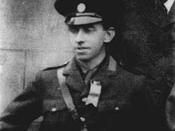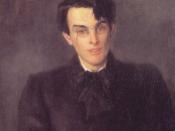Ireland has always been a country of instability. For six hundred years it has been occupied by English forces. For six hundred years, it has been divided at the hands of English implants. For six hundred years, the English presence has been threatening to decimate Irish cultural values. At the turn of the nineteenth century, a new movement to restore Irish heritage to the emerald isle was gaining momentum. It was a time of uncertainty. A new generation of Irish people was looking for an identity, and a new generation of artists was catering to them. They were embracing Irish culture and questioning the English presence on their island. Out of this cultural revival rose an unlikely hero. There rose a man, who, out of his own personal ambitions, became an inspiration to an entire people. William Butler Yeats became known as one of the greatest poet's in Irish history, and his writings inspired a nation revolution.
One of his poems in particular, "Easter 1916," was used to embrace the Irish cause. There was, however, a delicate intricacy to "Easter 1916" that evaded most of its readers at the time. Although "Easter 1916" was seen as a decidedly nationalistic poem, it hid undertones that questioned the very roots of the nationalist cause.
Yeats the Man
To understand his work, one must first understand Yeats himself. Over his life, Yeats was exposed to many political extremes that would later leave him searching for an identity. He was born in Dublin to parents of English-protestant descent, and he spent
most of his childhood far from Ireland in London (O'Brien 73). His parents strongly believed in British Rule of Ireland and they tried to pass those beliefs onto him (Galenet.com). Yeats's childhood was filled with social adversity: he was delicate physically, he was...


